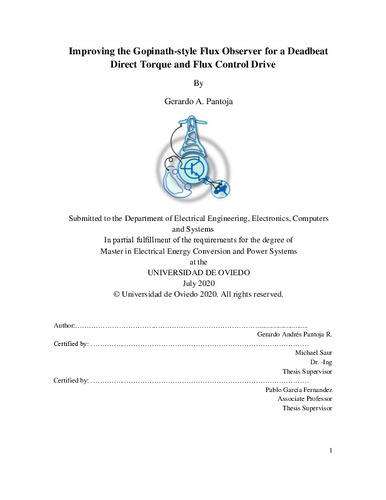Improving the Gopinath-style Flux Observer for a Deadbeat Direct Torque and Flux Control Drive
Autor(es) y otros:
Director(es):
Palabra(s) clave:
Gopinath-style Flux Observer
Gopinath-style Flux Observer for a Deadbeat Direct Torque and Flux Control Drive DB-DTFC
Gopinath-style Flux Observer
Iron Loses
Fecha de publicación:
Serie:
Máster Universitario en Conversión de Energía Eléctrica y Sistemas de Potencia
Descripción física:
Resumen:
The focus of this thesis is to study how to implement a high accuracy Gopinath-Style flux observer for the IPMSM of a DBDTFC drive for traction applications at Audi AG. The current implementation had a steady state error of and was known to be suffering of model transition distortion between the CM and the VM. Therefore, resulting in an undesired SS overshooting the torque estimation. The SOA average error is of 4.2%. This thesis proposes improvements for the model transition by means of the implementation of a Frequency Response Correction factor for the Observer. A more complex machine model for the IPMSM including Iron Losses. For which the Iron Loss resistances for no load tests as well as for a full torque speed plane were mapped. Moreover, the effects are evaluated via a steady state model of the machine. And finally, a decoupling through a new magnetics model is proposed and tested. Open loop experimental tests show that the implementation of the FRC observer as well as the introduction of an Iron Losses Model for the current, enhance the overall performance of the Flux-Observer. The asymmetry in the flux observer estimation between motoring and generating conditions is reduced. And a closer match for the torque estimation is produced with a maximum error of around 1.3% at the maximum speed. The new average estimation error is of 1.9%
The focus of this thesis is to study how to implement a high accuracy Gopinath-Style flux observer for the IPMSM of a DBDTFC drive for traction applications at Audi AG. The current implementation had a steady state error of and was known to be suffering of model transition distortion between the CM and the VM. Therefore, resulting in an undesired SS overshooting the torque estimation. The SOA average error is of 4.2%. This thesis proposes improvements for the model transition by means of the implementation of a Frequency Response Correction factor for the Observer. A more complex machine model for the IPMSM including Iron Losses. For which the Iron Loss resistances for no load tests as well as for a full torque speed plane were mapped. Moreover, the effects are evaluated via a steady state model of the machine. And finally, a decoupling through a new magnetics model is proposed and tested. Open loop experimental tests show that the implementation of the FRC observer as well as the introduction of an Iron Losses Model for the current, enhance the overall performance of the Flux-Observer. The asymmetry in the flux observer estimation between motoring and generating conditions is reduced. And a closer match for the torque estimation is produced with a maximum error of around 1.3% at the maximum speed. The new average estimation error is of 1.9%
Patrocinado por:
AUDI AG.
Colecciones
- Trabajos Fin de Máster [5288]
Ficheros en el ítem





